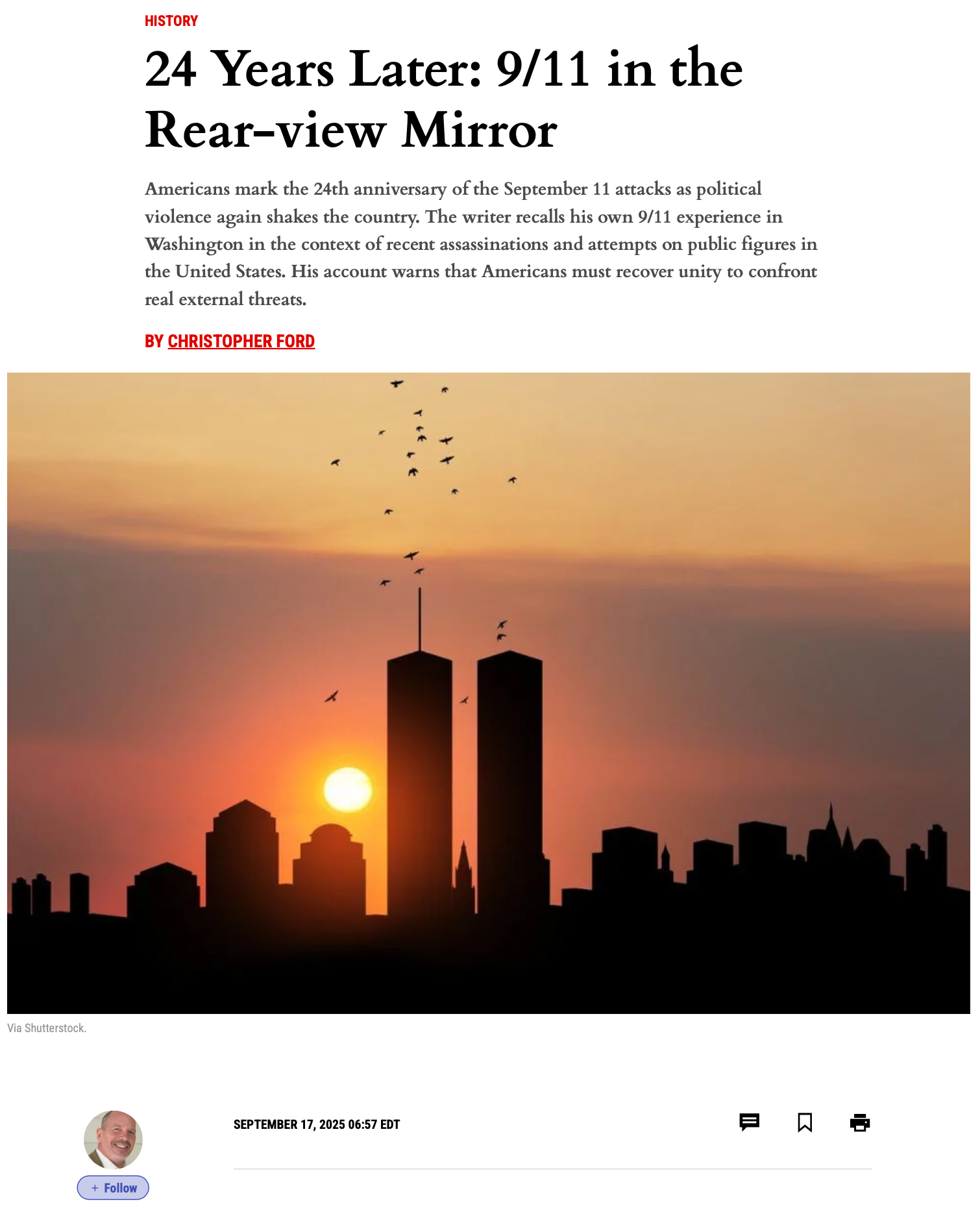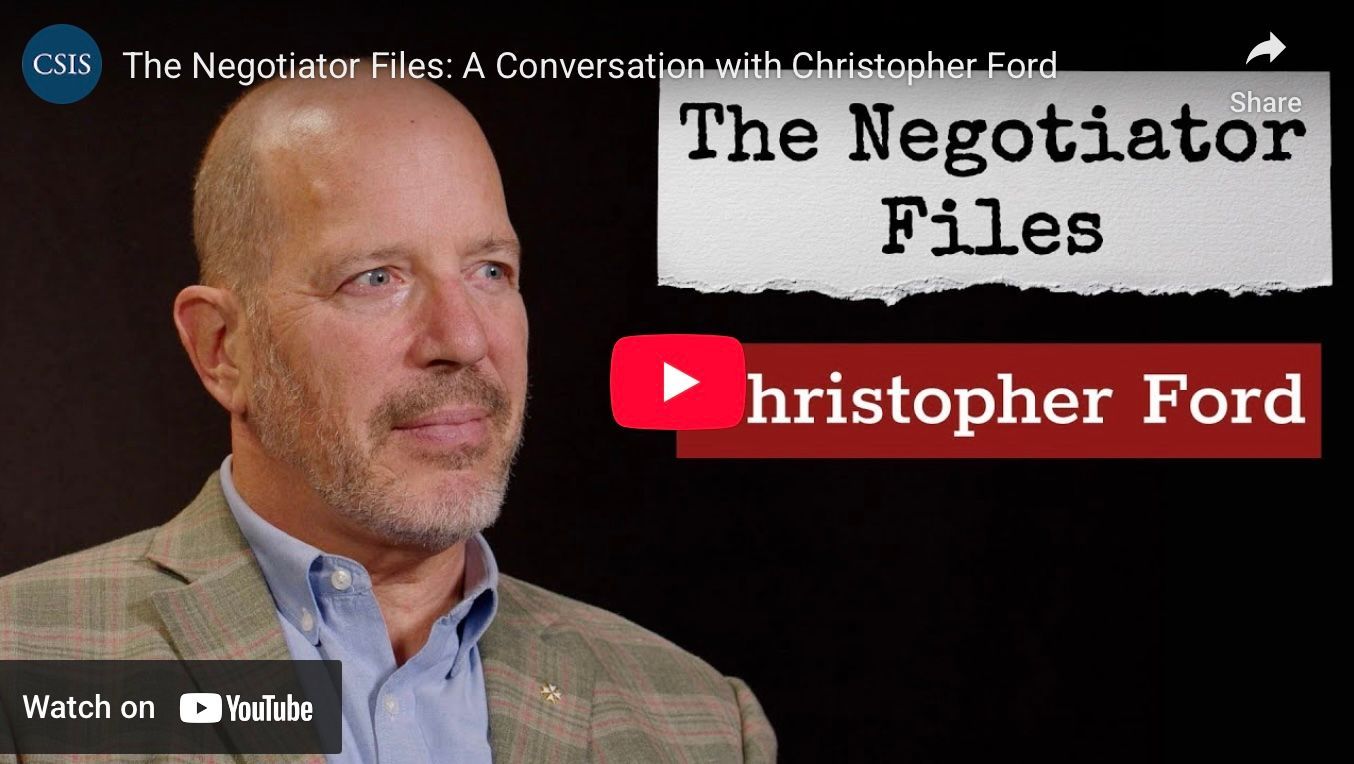U.S. Perspectives on Nuclear Weapons Deterrence and Use
Below is the text upon which Dr. Ford based his remarks at a conference in China on November 8, 2025.
Good day, everyone, and many thanks for having me to this important discussion on strategic stability. For this section of our event, I’d like to say a few words about current thinking about nuclear weapons deterrence and potential nuclear weapons use in the community of U.S. nuclear strategy experts.
These are only my personal views, of course, and they don’t necessarily represent those of anyone either at Missouri State or at CSIS. With that caveat, however, I do believe it’s possible to say some things about current American perspectives.
Remarkable Consensus
In this regard, it bears emphasis that as far as I can tell, the nuclear experts community in Washington today is more unified on nuclear weapons issues than I can ever remember them being before.
For as long as I can remember, until recently, U.S. nuclear weapons policy experts were sharply divided over many key issues related to nuclear modernization, deterrence, and force posture. I’m not referring to the longstanding and quite intractable division between those who support some form of nuclear deterrence and hard-core nuclear disarmament advocates in American civil society who do not – though that divide of course persists, and has done so even in periods like today in which grave national security threats have led to disarmament perspectives being marginalized to the point of insignificance in U.S. policymaking circles. Rather, I mean that for most of the last half-century, even the deterrence community has been internally divided over questions of how to achieve the stable deterrence of adversary aggression that its members desire.
During the early heyday of détente in the 1970s, for example, the details of U.S. strategic arms agreements with the Soviet Union – for example, in the Interim Agreement on limiting strategic offensive arms (a.k.a. SALT I) and the Anti-Ballistic Missile Treaty of 1972 – arms control with Moscow was accepted by mainstream Republicans and Democrats but remained controversial on the hawkish political Right. In the late 1970s and into the early 1980s, fueled by the Soviet Union’s massive nuclear build-up and growing global adventurism in the 1970s, expert policy debates flared in America over U.S. new weapons programs such as the canceled Enhanced Radiation Weapon (ERW, a.k.a. “neutron bomb”), the MX missile (a.k.a. “Peacekeeper”), the B-1 bomber, and the intermediate-range cruise missiles and ballistic missiles NATO deployed in Europe in response to Soviet deployments of SS-20 systems.
There were fewer disagreements in U.S. expert circles after the end of the Cold War when attention shifted from how to meet Soviet threats to how best to manage reductions in our nuclear force posture now that the U.S.-Soviet rivalry had ended. Even then, however, debates continued about the pace and scale of such cuts – as well as over the Comprehensive Test-Ban Treaty (CTBT), and whether Cold War-era limitations on ballistic missile defenses still made sense in the face of third-party missile threats from North Korea and Iran.
The early 2020s saw continued controversy in U.S. policy circles over our withdrawal from the ABM Treaty in 2002, the nature and extent of American “extended deterrence” deployments of nuclear gravity bombs in Europe, and whether the United States should develop “new” nuclear weapons such as the abortive “Robust Nuclear Earth Penetrator” and the “Reliable Replacement Warhead” programs. Policy debates flared still further in the mid- to late 2010s, fueled by the awkward coincidence of the Obama Administration’s disarmament-friendly agenda with Russia’s violation of the Intermediate-range Nuclear Forces (INF) Treaty and failure to honor its promises to reduce short-range nuclear weapons, as well as the Kremlin’s return to a posture of territorial expansionism with invasions of Georgia in 2008 and Ukraine in 2014.
In light of all these debates, however, what strikes me as remarkable today is the degree to which there isn’t major disagreement in the U.S. nuclear expert community anymore, at least for now. In the face of recent events – including Russian and Chinese deployments of new strategic systems and theater-range nuclear weapons for we have no counterpart, the resurgence of Russian territorial aggression in Europe, the potential for Chinese aggression against Taiwan or others in East Asia, and the huge nuclear weapons build-up now underway as Beijing sprints toward what will soon be at least numerical parity, thus creating for U.S. defense planners the vexing “three-body problem” of having to deter two nuclear peers at the same time – the U.S. expert community has recently reached an essentially unprecedented degree of consensus that a more robust U.S. nuclear force posture is now urgently needed.
You can see this new consensus, for example, in the unanimous bipartisan conclusions of the Strategic Posture Review Commission in 2023, which found that the current U.S. program for modernizing our strategic delivery systems was necessary but not sufficient – and hence that more weapons of some sort were thus needed if deterrence is to be preserved The similarly bipartisan and unanimous Commission on the National Defense Strategy endorsed this conclusion in 2024, while earlier this year the bipartisan and unanimous Senior Study Group on Strategic Stability at the U.S. Institute of Peace went even further, explicitly calling for uploading more warheads onto U.S. strategic delivery systems and for the development and deployment of new theater-range nuclear systems. Over this same period, the Biden Administration – which entered office pining nostalgically for the days in which President Obama could receive a Nobel Peace Prize merely fortalking optimistically about disarmament – came around to this view. By the late summer of 2024, in fact, Biden Administration officials were clearly signaling that in the face of growing nuclear threats in this “new nuclear age,” the United States had to “shift to a more competitive approach” and might soon “have no choice but to adjust our posture and capabilities to preserve deterrence and stability.”
Ours being a vibrant and diverse democracy that prizes free speech, there naturally exist some marginalized outliers still calling for complete disarmament. And even the expert community is bound to disagree more within itself as debates shift to specifically what new systems the United States needs, how many of them are required, and how much all this will cost.
That said, the degree of U.S. expert consensus today around having a more robust nuclear posture is quite extraordinary, and speaks volumes about the degree to which Russian and Chinese nuclear policies over the last decade or so have produced a new era of instability and arms race competition. In terms of sheer numbers, the U.S. nuclear arsenal has on the whole been shrinking since 1967, but it now seems that “U.S. nuclear policy is now back – more in sorrow than in anger, to be sure, but back nonetheless – in the ‘build-up’ business” again, for the first time in many decades. Some expansion of nuclear capabilities, American experts tend to feel, is now necessary to preserve deterrence in a context in which our strategic adversaries are expanding their own nuclear holdings, proclaim themselves to be in a “partnership” against us and in an alliance with nuclear weapons proliferator regimes, and seem disturbingly interested in invading and occupying their neighbors.
There does still remain interest in arms control among U.S. experts, though much less optimism about it than in previous years, thanks to Russia’s appalling record of arms control violations and China’s continued disinterest in even talking about arms control at all. An additional problem is the degree to which China’s enormous nuclear buildup casts a shadow over the possibilities for arms control even with Russia, since limitations that Washington might find acceptable vis-à-vis Moscow were we still in a purely dyadic relationship now also need to be assessed in the context of what America needs in order to be able to deter Chinese aggression as well.
(The need for augmented U.S. capabilities vis-à-vis China, for instance, is already emerging as a key reason why the United States may have difficulty accepting Vladimir Putin’s suggestion that Washington and Moscow extend the central limits of the New START agreement for another year. Moscow has a long history of proposing arms control limits designed to strategically disadvantage the United States, and I doubt it’s a coincidence that Putin decided we should extend those limits only after U.S. experts recognized that we need a more robust nuclear posture to meet the challenges of deterring two nuclear peers simultaneously. That’s something, of course, that Putin doesn’t want us to be able to do, and extending New START limits would preclude changes to the current treaty-dictated strategic warhead cap.)
There is a bit more optimism in U.S. expert circles about the possibility of risk-reduction steps or other transparency and confidence-building measures (TCBMs) with Russia or China. Even here, however, after several years of Biden Administration attempts to elicit such dialogue, China’s continuing general disinterest in negotiations casts a pall over things.
To some extent, therefore, the most optimistic vision for traditional limits-based arms control among U.S. nuclear experts today seems almost to entail first passing through a period ofU.S. counter-deployments of some sort in the hope of changing the concrete incentives facing Chinese and Russian leaders to finally make them take such negotiating seriously. This is, after all, what occurred with the so-called “Euromissile” deployments of 1983, which turned out to be exactly what was needed to entice the Soviets to agree to the INF Treaty of 1987. This conceptual model of deploy-and-negotiate first returned to the fore in the Trump Administration’s 2018 Nuclear Posture Review, and to the extent that arms control has a future at this point at all, such an “INF model” feels like the best that most U.S. experts now expect.
This, then, is the conceptual terrain in Washington which I would urge you to bear in mind as we have our discussions here in Shanghai today. President Trump clearly does seem to want some kind of nuclear weapons deal on “the nuclear” with China and with Russia, but it’s hard to avoid the conclusion that Chinese and Russian policies that have stacked the deck against any kind of dramatic solution in the short term. To the degree that the “INF model” – that is, undertaking countervailing deployments to meet nuclear threats and give one’s adversary concrete reasons to want to negotiate with you – does indeed represent a key pathway through which a Trumpian “peace through strength” agenda could catalyze arms control agreement, future progress may still be possible. But given the prevailing strategic circumstances, we should probably not get our hopes up too much.
Circumstances of Nuclear Use
Such is the context in which I think U.S. policy experts tend to see the challenges of deterrence today. A related question is about what such experts see as the most likely circumstances of nuclear weapons use.
To begin with, it’s worth remembering that most Western deterrence experts feel that it’s actually not a good idea to wholly preclude nuclear weapons use. That may sound paradoxical, but having nuclear weapons for deterrence basically requires at least some willingness to use them, since it’s precisely the possibility of potential use that does the work of deterring.
For this reason, though being too willing to use nuclear weapons would be powerfully destabilizing, it is to at least some degree essential to be willing to use nuclear weapons in the right circumstances: deterrence requires this, and this is especially true for the “extended nuclear deterrence” that the United States offers to its allies to preserve their security against aggression and reduce their perceived incentives to develop nuclear weapons on their own. So while keeping the risk of nuclear use as low as possible consistent with deterrence is clearly an important objective, entirely removing anysuch risk wouldn’t be wise unless and until the prospect of large-scale aggression – including purely conventionally-armed aggression, as well as attack with non-nuclear forms of WMD – can be reliably taken off the table.
As for the actual circumstances in which nuclear use is most likely to occur, most Western experts today do not seem to worry much about the kind of “bolt from the blue” first-strike threats that sometimes concerned U.S. planners during the Cold War. So far, the United States retains confidence in the survivable second-strike capability represented by its ballistic missile submarine fleet, and would appear that the overall deterrent balance of the central Russo-American and Sino-American strategic standoffs are holding.
Nor does there seem to be overmuch concern in Washington about nuclear weapons use resulting from an accidental or unauthorized nuclear launch, though such possibilities cannot be ruled out. The huge reductions in nuclear force posture since the end of the Cold War undertaken both by the United States and Russia have likely somewhat reduced the risk of such mishaps, as has the development of limited ballistic missile defense capabilities that can provide at least a partial buffer against such eventualities. President Trump’s “Golden Dome” missile defense will likely increase the effectiveness of this buffer, moreover, while also adding a greater capacity to cope with – and thus deter – potential adversary efforts to use limited nuclear strikes on the U.S. homeland for coercive bargaining purposes in a crisis.
Rather, the most likely circumstances of nuclear weapons use today are felt to arise from of escalation dynamics in a conventional war involving nuclear-armed participants, such as in the Western Pacific under a Taiwan invasion scenario, or in Central Europe in the event of Russian attack upon a NATO ally. Nuclear use could occur in such a context if one of the nuclear-possessing belligerents felt itself at risk of a catastrophic loss in that war, and if it calculated that crossing the nuclear threshold would turn the tide in its favor or somehow shock its opponent into war termination or limitation on reasonably favorable terms. (Another possible use scenario involves an adversary that seeks regional aggression but lacks confidence in its ability to prevail with purely conventional arms, and which therefore opts to combine a conventional attack with limited nuclear strikes in theater, trusting to the overall strategic standoff – and its numerical advantages over its opponents in theater-level nuclear force – to deter effective responses.)
Especially in the face of Western countries’ numerical disadvantage in theater-range forces in comparison either to Russian or Chinese deployments and their leaders increasingly naked territorial ambitions, it has become a central challenge for Western strategy to deter such escalatory choices by deploying more theater-class systems to put more “rungs” onto the proverbial nuclear “escalation ladder” before the level of a strategic exchange.
This need was already beginning to become a concern as early as 2010, when the U.S. Senate’s resolution of ratification for New START made clear that any future arms control agreement with Russia needed also to include non-strategic weapons, a category in which Moscow even then enjoyed a considerable advantage. The need for more options in response to Russian and Chinese advantages in such systems was also the reason for the First Trump Administration’s deployment of a low-yield warhead option (the W76-2) for the Trident submarine-launched missile as a sort of interim or “bridging” solution, and for our initiation under that administration of the Submarine-Launched Cruise Missile-Nuclear (SLCM-N) program. Building more theater-range capabilities – both in nuclear and in conventional systems – to offset destabilizing Russian and Chinese advantages and propensities to coercive bargaining is today an area of increasing agreement among the broad body of U.S. nuclear policy experts.
Conclusion
To sum up, I don’t think the basic theory underlying nuclear deterrence in Western minds has really changed at all. Instead, what has happened to create today’s remarkable degree of U.S. expert community consensus in favor of an augmented nuclear posture at both the strategic and (especially) the theater levels is the direct result of changes in the security environment created by China’s nuclear build-up, Russian and Chinese advantages in theater-class nuclear weaponry, Russia’s turn to regional aggression for purposes of territorial expansion, and the prospect of China’s invasion and annexation of Taiwan. In the face of these developments, Washington’s nuclear policy experts feel that more U.S. capabilities are required if deterrence is to remain stable in the future.
Advances by America’s adversaries have thus managed to accomplish what decades of doctrinal, ideological, and academic debate could not: they have brought about a notable degree of agreement in favor of a robust, deterrence-focused agenda of force posture augmentation among nuclear policy experts on both sides of the political aisle in the United States.
I hope this outline of thinking in U.S. nuclear policy circles has been useful, and that it will help contextualize our discussions here on strategic stability.
—Christopher Ford







